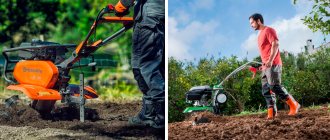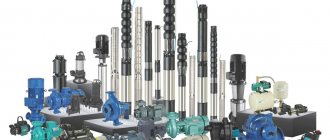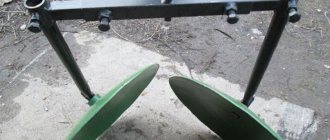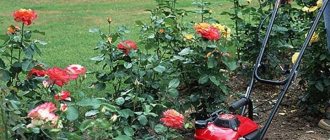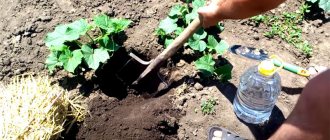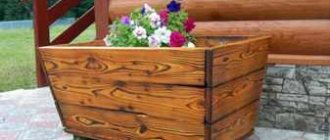General description of the cultivator
In small areas or in hard-to-reach and very narrow places, large equipment will not be able to pass, so a hand-held cultivator for a garden can be very useful. This is the simplest and cheapest type of agricultural machinery. Such a cultivator allows you to perform almost any manipulation related to soil cultivation.
Loosening, removing weeds, weeding, moon digging for seedlings and flowers, mixing fertilizers - a hand cultivator can handle all these tasks. These devices are especially popular among gardeners, because they are very convenient for processing , etc. Although some craftsmen use hand-made homemade cultivators, there are many models of tools on sale today. To understand their diversity, you need to delve deeper into this topic.
Kinds
Root remover
A manual root cultivator for the garden will help you fight weeds and dig small holes for seedlings. Operating principle: due to sharpened spiral teeth, by turning the gate, the device is “screwed” into the ground. The small area of contact with the ground allows this to be done with minimal effort.
Root remover
To do this, it is enough to make no more than half a turn around the axis. After deepening, using the handle and axle as a lever, the earth along with the roots of the weeds is removed out. It is very easy to operate and the performance is high.
tornado hand cultivator has a very successful (and at the same time simple) design . The height of the collar is easily adjustable, which will allow a person of any height to work comfortably and not create a large load on the back. Showed excellent results when cultivating soil of varying degrees of hardness.
Choose models that come complete with various working attachments. In the future, the necessary ones can be purchased separately.
Petrol
A manual cultivator for a garden, a gasoline one (or a motorized cultivator) will be the most universal solution. The scope of its application is expanded by various replaceable attachments and attachments.
There is a huge selection of models on sale - from light (10-50 kg) to heavy walk-behind tractors (up to 500 kg), the performance of which is already close to a mini tractor.
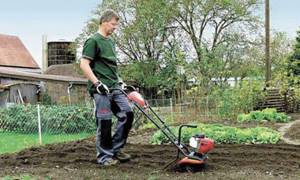
Petrol
When choosing, do not be tempted by cheap models from unknown manufacturers - in the future there may be problems with maintenance and purchasing spare parts. Take a closer look at time-tested brands, for example: Tarpan, Patriot, Champion, Texas, Viking, Cayman.
For hand-held cultivators for a summer residence, the price can vary from 10 to 40 thousand rubles (gasoline cultivators) and reach up to 150 thousand rubles for walk-behind tractors.
Electric
electric hand cultivator for a summer residence is lighter and easier to maintain than its gasoline counterpart. The main purpose is to loosen the soil. Advantages:
- light weight;
- ease of operation;
- low noise level;
- no exhaust gases;
Clearly visible in the photo:

Electric
When choosing, do not chase powerful models - anyway, he will not turn out to be a full-fledged “field worker”. Pay attention to lightweight, inexpensive models, for example Loplosh, Mantis, which a woman or an elderly person can easily handle.
Disadvantages include dependence on a source of electricity . Not suitable for processing areas with unmown grass. Due to its relatively low power, it is capable of loosening only soft, sandy soil or cultivated black soil.
Star
A manual garden rotary cultivator (or star) is used to loosen soil and clods after plowing, mix soil with fertilizers and remove weeds. Operating principle: “arms” are attached to the working shaft at right angles, at the end of which there is a cutting edge.
Mining dump trucks stand apart in the family of trucks. Here is an article about the first among the giants, Belaz 75710.
The MAZ 5551 truck has been produced by the Minsk Automobile Plant for more than three decades, since 1985. MAZ 5551 is maneuverability, practicality and reliability.
There are penalties for violators, one of which is the towing of the vehicle. Here's what to do if your car is taken by a tow truck.
There are several such elements along the entire length of the circumference, and in lateral projection they resemble an asterisk. Hence the name. With a gasoline or electric drive, the sprockets rotate quickly (regardless of the speed) loosening the soil.
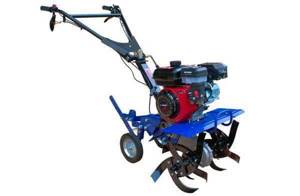
Evezdochny
The manual cultivator for the garden is a star type without a mechanical drive, and has a pair of small support wheels. Also included is a knife, which (if turned towards the ground) cuts off grass and weed roots as it moves.
Immediately after purchase, it is better to replace the handle with a longer one - it will be much easier to work.
Rotary device type
The rotary cultivator makes it very easy to loosen soft soil. The design of such a tool includes a cutting shaft with mounted disks in the shape of a star. The more gear parts installed in the cultivator, the wider the gripping area of the device will be. The disc-type cultivator is placed on a comfortable handle, which allows you to avoid bending over while working. It is very simple to use: the device is placed vertically in the soil, the stars are located exactly between the rows, and an arc is located above the bed.
The equipment is driven by physical force. The cultivator sprockets cut into the soil and turn it upside down. Thus, the device simultaneously removes weeds and loosens the soil. Manual star models are perfect for cultivating soil for cucumbers and high-quality potatoes. They are also very convenient for preparing flower beds and lawns. The only disadvantage of this tool is its inability to process clay soil.
Operating principle
Cultivators for manual tillage are divided into two groups: rippers and rotary models. Representatives of the first variety are shaped like a hand equipped with three or five metal “fingers.”
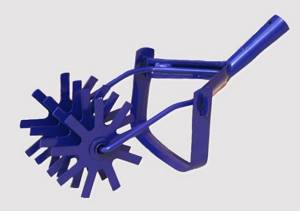
Cultivator for the garden
In essence, this is a highly modernized hoe, which requires a lot of physical effort to operate. Therefore, this option is more suitable for working in greenhouses. The working element of rotational models is made in the form of stars, with a large number of rays.
During operation, the stars literally “bite” into the ground, loosening the soil and at the same time cutting and crushing weeds.
How to use a rotary cultivator with stars? Due to the simplicity of the design, this device is quite easy to handle.
The unit is installed vertically in the ground, the standard position of the cultivator: the stars are located between the rows, the connecting axis passes over the bed. The cultivator is driven by applied forces.
Even taking into account the fact that the driving force is a person, cultivating the land is much faster than when performing similar actions with a shovel or hoe.
Almost all models of manual rotary cultivators are equipped with additional wheels, which makes it easier to move the unit around the beds. In addition, the product can be attached to a long handle, which allows you to work without bending your back.
This point is very important for pensioners who often suffer from radiculitis; in fact, they are the main buyers of this type of gardening equipment.
Root remover and its features
This cultivator is equipped with a sharp, spiral-shaped toothed rod and a handle. When working, the tool cuts deep into the ground without causing any damage to the plantings .
To process the device, you need to place it vertically, press lightly and turn the handle. The device will stick into the soil, and its rod will grab the earthen lump and cut the root of the weed plant, which can be easily pulled out. The advantage of root removers is that they do not harm the structure of the earth, unlike cultivating the area with a shovel. However, using this device requires a lot of physical effort, so it is more suitable for people with strong hands.
What types of manual units are there for summer cottages?
Star or rotary . Its operation is ensured by a small shaft with sprocket disks. The cutting mechanism uses sharp teeth to grab, lift and turn out the soil. Thus, digging and weeding occurs simultaneously. The cultivator comes with an adjustable handle. It allows you to work without bending over. This type of device is most convenient for treating hard-to-reach places. Often, a special knife attachment is sold complete with a cultivator, which can cut off weeds from the roots.
Ripper. This model has no mechanism at all. At the end of the device there are 3-5 teeth with flat plates. They cut deep into the ground. By pulling the device towards you, you loosen the ground. If you lower the cultivator with force, you can break through even the dense crust that appears on the surface after compaction or heavy rainfall. There are two types of rippers: regular size, for the garden, and miniature with a short handle, for indoor plants.
Root remover . It looks like a pole with oblong, spirally curved, jagged fingers at the end. It will help to quickly and accurately remove the roots of weeds and other unnecessary plants on the site. With this cultivator you can also loosen the soil and even dig holes in it for seedlings. At the same time, the device does not harm the structure of the soil, mixing the fertile composition unnecessarily.
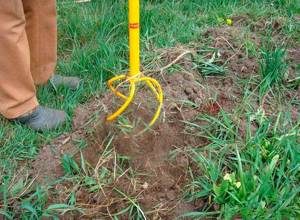
Root remover
Potato digger. Similar to a root remover, only the teeth are curved differently. This cultivator makes it easier to remove ripened potatoes from the soil.
Attention! To work with a root remover and potato digger, you need no less strength in your hands than when using a regular shovel. But these cultivators allow you to remove the load from the spine and distribute it between the muscles of the legs, shoulders and back. A significant disadvantage of both types of devices is their inability to process heavy clay soils.
Ripper models
The ripper is a durable metal rod with several teeth designed to eliminate weeds. On the top of the tool there is an arc-shaped handle for control. When starting to work with a hand ripper, you need to swing it properly and drive the device deep into the ground. After this, you need to turn the handle and pull it towards you.
One of the advantages of this device is the uniform distribution of the load during operation. The disadvantages include the inability to process large areas. If the weeds have grown very intensively in the area, then the operation of such a device will be very ineffective, because it requires enormous effort. There is also the possibility of accidental damage to the rhizomes of cultivated plants.
When working on the site with a ripper, it is imperative to follow all safety rules, otherwise the sharp teeth can cause serious injuries. Before using the tool, you must wear durable and fully closed shoes.
Potato diggers and other units
Any summer resident who grows potatoes every season is well aware of the features of a potato digger, because this tool is very useful for harvesting. If you dig up potato fruits with a shovel, you can get tired very quickly. A great alternative is a potato digger. This tool has a very simple design, which consists of a handle, a strong rod and sharp teeth at the bottom. The height of the device can be adjusted, which makes this tool very convenient for any gardener.
There are special tools for greenhouse or indoor plants. They are distinguished by shortened handles and compact sizes. They allow you to prepare holes for planting bulbs of a wide variety of plants, loosen the soil next to flowers and remove weeds. They are very convenient and simple to use, because processing a small container requires almost no physical force.
Making a cultivator with your own hands
If you have time and desire, you can make a cultivator with your own hands. Many designs can be made from scrap materials, while others will require additional elements. One way or another, the cost of a homemade device will be much less.
For example, to create a compact tool, you can attach durable metal sprockets . After this, all that remains is to choose a comfortable handle. The cutting parts need to be sharpened properly. For another design, you can use an unnecessary bicycle frame, attaching iron rods, a sap, a plow or part of a broken cultivator to it. The handle can be made from metal pipes. After assembling the base, you need to fix the wheel on it, which should be of medium size.
There are other models of homemade tools, but they require more thorough knowledge and skills in plumbing. In addition, many craftsmen manage to make gasoline and electric cultivators from “garage” products.
Advantages and disadvantages of the tool
As a rule, farming involves physical work, so cultivators are popular because they make it easier. The advantages of such a tool include the following:
- ease of use;
- no maintenance required (fueling, lubrication);
- careful processing;
- the ability to work in hard-to-reach and delicate areas (greenhouses, rose gardens, places between bushes and trees, flower beds).
The most basic disadvantages of the devices are:
- obsolescence;
- the need to change discs from time to time (in rotary cultivators);
- low performance indicators;
- physical effort required;
- low efficiency on hard soil and virgin soil.
Hand cultivators must be used very carefully. If you press too hard on the device, you can damage the roots of the crops.
Hand cultivator: description and class characteristics
Gasoline or electric cultivators today are quite popular among those gardeners who protect their personal time. The technology is not that expensive and quite economical. However, it is often not able to cover all the needs of the owner of a summer cottage. Such cultivators are quite large and have a gripping range that is too wide to successfully cultivate narrow and disproportionate pieces of land. For example, between trees or bushes, corner sectors, areas near fences, alpine slides, ridges, rose gardens, beds with valuable varietal vegetables or root crops.
Attention! Manual models are quite easy to use.
A manual cultivator is the best option for small areas. With its help you can perform any work: plowing, cultivating, cutting beds, weeding, etc. The unit is perfect for long, level and not very wide beds. But it is not advisable to use it on large plots: cultivating so much land by hand is quite labor-intensive.
Other advantages of this class of cultivators:
- small weight;
- small size;
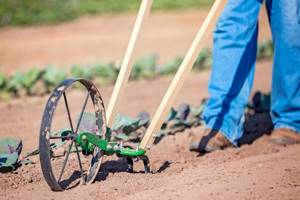
- strength - everything in the device is based on durable mechanics and manual drive;
- higher level of safety compared to electrical and motorized devices.
Advice. The experience of summer residents shows: with this device you can easily process a plot of up to 6 acres.
